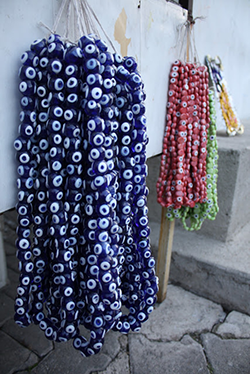The smell of molten glass was sweet and deceptively inviting. I was crouching near four artisans who squinted as they poked metal rods into the yellow-hot maws of a furnace made of clay. Wearing jeans and ball caps, the artisans, all men, were shaping nazar boncuğus, amulets that have been warding off the evil eye in what is now Turkey for millennia. The 100-year-old furnace, unevenly shaped and studded with recent modifications of rebar, appeared more like a disturbing sculpture than something that restrained 1,700 degrees Fahrenheit. From my distance, however, the waves of heat faded into a pleasant warmth against the briskness of an Anatolian winter.
I was in Kurudere, a mountain town better known as Nazar Köy — Evil Eye Village. But I had met with the gaze of the nazar boncuğu (pronounced “nahzar bonjoo”) — nazar translating to evil eye and boncuğu to talisman — every day since I’d arrived in Turkey. Usually fashioned from a disk of cobalt-blue glass with a light blue or yellow iris, the nazar boncuğu hangs wherever a Turk feels it is necessary to neutralize the bad luck and insatiable wrath of the evil eye, the supernatural bogeyman that attacks its believers with nothing more than a stare. Unexplained maladies. Fallen livestock. Turks have blamed them on the invisible but dreaded death rays of the evil eye.
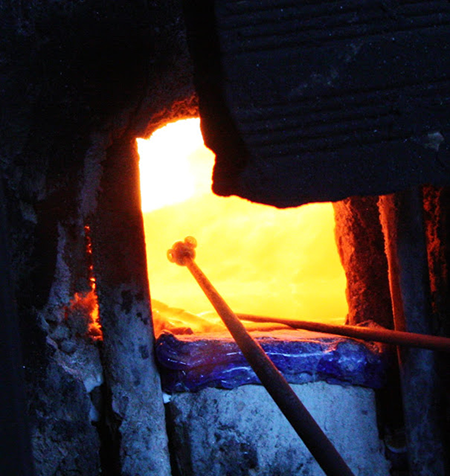
Even worse, the evil can originate from anyone’s stare, even involuntarily. Someone may be unaware that his casual glances are inadvertently inflicting curses left and right. That is where the nazar boncuğu, with its untiring stare of its own, finds its calling, attracting and destroying the evil eye on its own ocular turf. The nazar boncuğu serves as a handy lightning rod against wickedness.
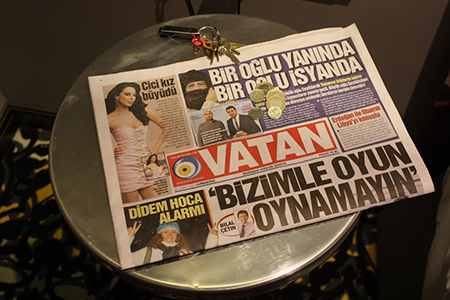
Attached to the ventilation hoods above charcoal grills; festooned with blue fur and dangled from rearview mirrors; used as the logo of Vatan, a Turkish daily newspaper — these were some of my favorite nazar boncuğus on the frontlines of paranormal battle. I have never paid much attention to superstition, but here in Turkey, my outsider’s stance fueled my curiosity for this cultural fascination. Soon I had become fascinated by the fascination itself. A fascination that led me to the sight — and smell — of freshly shaped talismans.
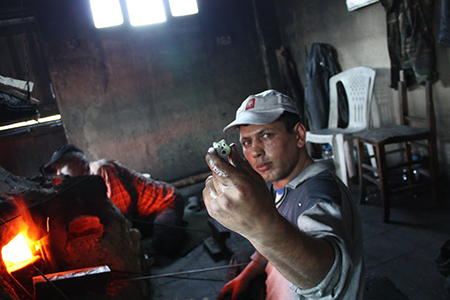
I had only been in the furnace room for a few moments, but somehow, smudges of soot had already found my arms, elbows, and knees. My wife, Melanie, stood beside me, and behind us stood Mehmet, our cab driver, who had taken us from the coastal city of Izmir. To reach Kurudere, my wife and I could have taken dolmuşes, Turkey’s extensively-networked but narrow-seated workhorses of public transport. But we figured an English-speaking taxi driver would help us past the limitations of our restaurant Turkish so we could communicate with the artisans. We had found Mehmet through our Izmir hotel, but what they did not tell us was that his English was scantly better than our Turkish.
On our drive from Izmir, climbing Asia Minor’s craggy lip, the three of us had weaved together a dialog with pieces of both languages, discussing the Turkish singer Petek Dinçöz, whose fusion of traditional Turkish instruments and melodies with electronic loops we’d enjoyed in the restaurants of Istanbul and Izmir alike. We talked about our favored Turkish foods — like kaymak, a rich, buttery spread that pairs up nicely with a freshly baked simit, a sesame seed-studded ring of bread. Mehmet looked to be in his late 30s, but had the gleam of a man whose age has been disguised by contentedness. His soft gaze unbreakable, Mehmet projected a composure I found reassuring in an atmosphere of language difficulties. In the cab, he had told us in our newly formed patois that we spoke Turkish well. I smiled and disagreed, to which he deadpanned, “But you know kaymak, nazar boncuğu, Petek Dinçöz!”
I knew kaymak and Petek would not bring us very far in Kurudere, which was why the furnace room remained quiet, save the ringing of rods tapping each other and the abacus-like clinking of finished beads, still bright orange and the texture of caramel, flicked into cooling chambers built into the side of the furnace.
Soon, the beads would be joining an army of talismans already on duty across the country. A few days before, I had spotted an anti-nazar talisman in a display case of iced fish outside an Izmir restaurant. Of course, one expects to find many eyes staring back from a Turkish fish case, as the chef places the fish whole onto the ice to allow the knowledgeable diner to discern freshness based on the clarity and protrusion of the eyes. My first impression was that the talisman served as a decoration, powerless but pretty, but it looked oafishly out of place among dead sea creatures. It was the size of a coffee can lid, an inedible shade of blue, dangling above the ice.
In a fish case? For what purpose? To keep the fish from stinking? We began to accept that an evening in Turkey would not be the same without a nazar boncuğu or two watching over us from somewhere, dutifully defusing our unintended evil for the comfort of everyone around us. Including the comfort of dead fish, helpless as they are.
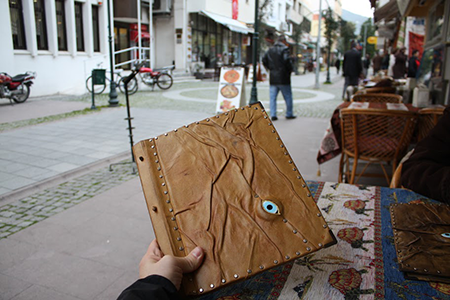
If the restaurant were employing the amulet to safeguard our meal, they would be perpetuating a belief that has been haunting the Eastern Mediterranean for at least as long as humanity has been recording history. Exactly where the evil eye eagerly bored into its first victim is unknown, but the earliest acknowledgement of its powers indicates an origin in ancient Egypt. The evil eye has seen the birth and death of Latin, outlasted the practice of bloodletting with leeches, and outlived empire after ravenous empire. It is as old as syphilis. But unlike syphilis, a passing stare is all the evil eye requires to infect its next host. The perfect contagion.
The eyes, after all, are often credited with more than the ability to see. They are the most expressive part of the face, and can convey universally understood feelings of hate, happiness, disgust, shock and countless others. Eye contact was likely a form of simple communication before spoken language arose. A silent dialog shared by man and beast alike.
And now, despite eras of evolving linguistic expression, filled with verbal tools for clarity and nuance, the eyes spoke the only dialog that the Kurudere artisans and I shared. What were they saying? I met with brief glances from faces aglow in orange, betraying a fleeting curiosity for the foreign visitor, along with a semi-detached gaze into the furnace, suggesting a mastery of the task or a mind keen to wander about: is there enough gas in the car?
•
The evil eye has found recognition outside the Mediterranean region, as far away as Latin America and India. But Turkey is where the concentration of the protective talismans points to an incomparable obsession. The frequency of nazar boncuğus trumps that of public portraits, statues, and posters of Ataturk, Turkey’s beloved founding father, a feat not easily accomplished. After the Ottoman Empire collapsed in the wake of World War I, Ataturk implemented widespread reforms that threw off the chains of theocratic rule and modernized the nation, separating religion and state. He voiced disapproval of irrational institutions, and as noted by biographer Andrew Mango, Ataturk has been quoted as saying “at times, I wish all religion at the bottom of the sea” and “superstition must go.” But the evil eye survived his watch.
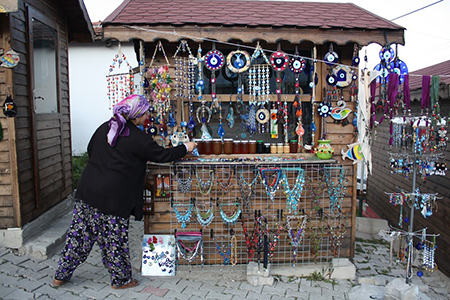
And still brazenly lurks. Modern nazar boncuğus are manufactured in factories and are made from glass, plastic, or in handy decal form (finding their way onto vehicles’ gas tank doors and anywhere else a dangling talisman may not be practical). Such mass-produced nazar boncuğus double as popular tourist keepsakes at Izmir’s markets. Perhaps the frequency of the talismans I had been seeing in Izmir had something to do with the fact that the city is near two towns — one of which being Kurudere — that still make the talismans according to old tradition, by hand in pine-fed furnaces.
•
Clink, clink, went another bead into the cooling bin. The artisan closest to me had taken off his sandals, leaving his feet, clad in only socks, poking into the spill radius of whatever unforgiving, lava-like goop may fall from the furnace window.
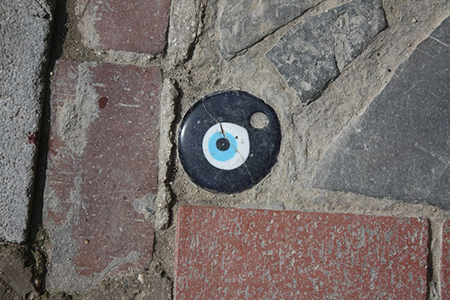
I noticed that Mehmet had been engaged in a patient dialog on his cell phone, which he handed to me. “My friend, he speak to you.” I thought a small, mountainous village was an odd place to receive a call, especially since no one knew I was there except the taxi driver. But Mehmet also knew I wished to speak with the artisans, and being cognizant of the limits of our festive but ineffective communication, he had called Serkan, a friend who works as a concierge at a top-shelf hotel back in Izmir. On the other end of the cell, an unwearied, cordial voice assured me that each question could be translated if I would then hand the phone to Mehmet, who would ask the artisans. In theory, the whole chain could then reverse.
I was not convinced of the soundness of this ad-hoc system, but after a few indulgent breaths of warm, candy-scented air, I began with a question that only required a numbered timeframe as an answer. How long does it take to become proficient at making nazar boncuğus?
The sandal-free artisan answered in a pleasant, conversational tone while he scooped up a glob of scorching taffy from a small pool just inside the furnace, twirling the rod to spin the glob into a ball. He flattened the ball onto an anvil-like block of metal and pressed the disk into the side of a bead on another rod, creating an iris. I wondered how the artisans could tell the glass colors apart, especially when blending; at such temperatures, almost all colors emit the same orange-red glow. Mehmet handed the cell phone to me. “He said it takes two weeks, but to master it, years.”
I felt a little like Lewis and Clark trying to find directions over the Rocky Mountains by relying on an ungainly string of multiple linguistic layers of their expedition. Emboldened, I tried a more open-ended question, asking why they chose to become artisans who make evil eye amulets. The men, their legs bent up beneath them, still focusing into the furnace, all began to contribute to the answer. “They say it’s a family run business,” Serkan said as smoothly as if he were saying “Airport pickup is complementary for our guests.”
I was also able to learn that the family of artisans is in its third generation; that each artisan — whether brother, cousin, or uncle — can make about 500 glass pieces per day; that no more furnaces remain in Izmir due to the inherent soot and fumes. When I scanned the artisans, their gnarled bodies perpetually hunched toward a caged fireball, I asked what they found to be the most difficult part of their task. Perhaps dealing with leg and back cramps, cataracts from infrared radiation, or just monotony?
And then there was the intimate proximity to 1,700 degrees. It’s a number so large it seems abstract, all while a runaway drop of glass from the furnace can greedily chew off skin before the nervous system will figure out how badly things have ended.
Chatter went around the furnace as if they were on barstools at a pub, with rods in their hands instead of mugs. The cell phone returned. I had overestimated the artisans’ preoccupation with discomfort: “The most difficult thing is getting the correct blue color.”
Melanie reentered the furnace room. She had already shopped at all eight or so kiosks of nazar boncuğu-themed artwork and jewelry along the perimeter of the town’s adjacent square. I was looking forward to browsing the kiosks and the plaza itself, a peaceful plaza where patterns of cookie-sized nazar boncuğus were mortared into its walkways overlooked by whitewashed buildings and a mosque’s lone minaret. But my wife’s entrance reminded me of how much time had passed. I had only managed to ask six questions. Realizing how much of the artisans’ time I must have been stealing, along with that of a luxury hotel concierge and a cab driver, I knew I had to wrap up the interview. My final question would be the one I had wondered about the most, the one my proud logical wiring had been begging me to ask: Do they believe that the nazar boncuğu can neutralize the evil eye?
As I surrendered the cell phone to Mehmet, I began to feel guilt over the unavoidably Machiavellian nature of asking other questions first to gauge their openness and gain their trust. In truth, I was curious about their earlier responses, but only because I eventually wanted to know what a naked inquiry on their beliefs might reveal. Perhaps a dose of lore explaining how the magic dimension intersects with flesh. Perhaps the unquantifiable depths of their devotion that could only be grasped by understanding what it means to be Turkish itself.
I had set a trap, and there was no going back. If they answered affirmatively, they risked appearing as quaint as farmers protecting their sheep with Frisbee-sized amulets hanging from fence posts — something I had seen the week before. If they rejected the belief, they might appear as snake oil salesmen preying upon the ignorant and fearful.
The men put down their rods and turned to Mehmet, the first time they had done so. Nods bounced the ball caps in sharp dips and twists. They didn’t need time to think about their answers. I had been squatting in the same spot, but now the heat of the furnace gnawed at my face.
Mehmet stood motionless, the phone tight against his head, as if he were not sure whether to hand it over. I looked to the artisans for clues, but only found cheekbones and foreheads tightly plugged back into the radiance of the furnace. Mehmet passed down the phone without looking at me. “Their answer is hard to translate, but I will try,” Serkan said. “They say it’s a basic human belief.”
Just as a talisman may neutralize the evil eye, the artisans had neutralized my question. More importantly, by passing the ball to the court of humanity, they had sent me reaching far past the shores of Anatolia. I thought of uniquely-evolved yet similarly intangible traditions across many other societies, such as China’s auspicious number eight, or the Cambodian’s belief that a tattoo has the power to allow bullets to pass through one’s body without harm, or the lack of 13th floors in American high rise buildings (even though, technically, the floor labeled 14 is the 13th floor — don’t tell the realtors or, more importantly, the tenants). Witches, warlocks, spells cancelling spells. A severed rabbit’s foot keychain. Bird shit on your shoulder.
Even Ataturk himself, while publicly modernizing Turkey with teachings of science, often sought omens in his dreams.
I can’t think of a society that doesn’t nurture some belief in the supernatural, something that conveniently operates around the known laws of physics. Something that indulges a desire to control the uncontrollable. To circumvent cold, unyielding reality.
•
I went to Kurudere to find something uniquely Turkish, but I ended up with something uniquely human. I also left with a bag full of amulets. Some had been strung in a round pattern like orb-studded dream catchers; some in bead form, so no matter how the bead is oriented, an eye is always in view; others had been flattened into the shape of hard candy, a fitting result after I had been sucking in lungfuls of sugary air. Perhaps the evil eye, underneath all its cruelty, has a sweet tooth.
My favorite piece had been shaped into a fish and featured a talisman disguised as the creature’s eye. I suspect it is marketed towards people with proud logical wiring who need to justify the use of a superstitious charm by having it framed within art. • 3 July 2013
